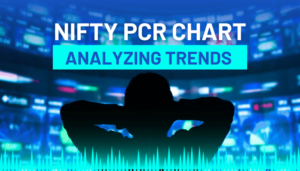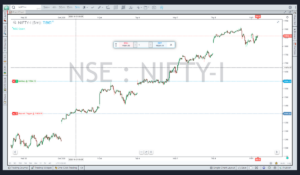
An essential tool for investors as well as traders on the Indian stock market is the Nifty PCR chart. It offers perceptions of the mood of the market and possible trends. The importance of Nifty PCR charts, their interpretation, and trading tactics are all covered in this article.
We’ll also discuss helpful tools, and practical examples while highlighting the drawbacks and hazards of using Nifty PCR charts. Anyone trying in order to make their way through the complex world of Indian stock trading will benefit greatly from understanding these charts.
Understanding Nifty and Put-Call Ratio (PCR)
Nifty: The benchmark stock index in India is the Nifty 50, sometimes known as the Nifty. The 50 largest and most liquid stocks listed on the National Stock Exchange (NSE) are included in it. The Nifty is frequently used as a proxy for the performance of the Indian equity market as a whole.
Put-Call Ratio (PCR): The Put-Call Ratio is a technical indicator that contrasts the overall open put options with the overall open call options in a specific market or security. In order to determine market sentiment, it is utilized. A high PCR implies a bearish attitude, whilst a low PCR reflects a bullish attitude.
Why Nifty PCR Charts Matter

Because they provide a succinct summary of market sentiment toward the Nifty index in India, Nifty PCR charts are important. Traders and investors can tell if the market is bullish or bearish with only a quick scan. Decision-making, risk management, as well as trade timing all benefit greatly from having this knowledge.
Extreme PCR results may signal probable reversals and act as contrarian indicators. Market participants can get an advantage, improve their trading techniques, and respond to shifting market conditions by following Nifty PCR charts, which eventually enables them to make more intelligent and successful investment decisions in the dynamic Indian stock market.
Also Read : Tick Chart Trading: The Complete Guide
Interpreting Nifty PCR Charts
The Put-Call Ratio’s present value and historical context must be taken into consideration when interpreting Nifty PCR charts. Typically, a PCR above 1 denotes gloomy emotion and foreshadows a likely market downturn. A PCR below 1 on the other hand denotes optimistic emotion and a possible rising market trend. Extreme readings that are well above or below 1 could signify overbought or oversold conditions, which could portend market reversals.
Furthermore, it is of the utmost importance to keep track of the relationship between Nifty price changes as well as PCR levels because divergence can indicate a shift in trend. The key to accurately interpreting Nifty PCR charts is to combine this research with other technical and fundamental indicators to gain a thorough understanding of the market.
Also Read : What is Paper Trading ? Benefits of Paper Trading
Using Nifty PCR for Trading Strategies

Nifty PCR may be an advantageous component in trading plans. It is frequently used by traders for contrarian strategies, going against the grain during extreme PCR readings. It can also act as a confirmation tool, assisting traders in making choices that are consistent with the mood of the market as a whole.
By recommending position sizing in accordance with the sentiment, Nifty PCR also assists in risk management. Combining PCR analysis with various other indicators in trading methods increases the accuracy of entry and exit points, resulting in better decision-making.
Nifty PCR Chart Tools and Resources
1. Charting Platforms: Nifty PCR charts with a variety of technical analysis elements are available through online charting platforms like TradingView and StockCharts.
2. Technical Analysis Software: Advanced charting features are available in professional software suites like MetaTrader and AmiBroker for in-depth examination.
3. Financial News Website: Websites containing financial news: Sites like Bloomberg, CNBC, and MoneyControl provide real-time PCR chart data combined with professional commentary and news updates.
4. NSE Website: Traders and investors can get the Nifty PCR chart and other pertinent market data on the official National Stock Exchange website.
Examples of Nifty PCR Chart
The Nifty PCR chart might show a value of 1.2 in this case. This shows a general market bearishness, which can portend an oncoming downfall. Traders may use this as a chance to think about short positions or put risk management techniques into practice.
On the other hand, if the Nifty PCR chart displays a value of 0.8, it denotes a bullish mood as well as points towards a possible upswing. In these circumstances, traders could swing into long positions or constantly watch the market for entry points in an effort to take advantage of the upbeat mood.
Also Read : Backtesting Trading: A Step-by-Step Guide
Risks and Limitations
1. Lagging Indicator: Because Nifty PCR reflects previous options data, it is a lagging indicator. When extreme readings first occur, market trends can already be underway, which could lead to lost trade opportunities.
2. Market Volatility: Sudden jumps in market volatility may result in a substantial impact on PCR, affecting its accuracy. During these times, PCR is less dependable since unexpected occurrences or news releases might cause quick changes in opinion.
3. External Factors: Options data alone do not entirely determine market sentiment. It is vital to take into account more general market dynamics because economic events, geopolitical developments, and company-specific news can overrule PCR findings.
4. False Signals: Market reversals are not always assured by extreme PCR readings. If traders only on PCR for making decisions, false signals could happen as well as result in losses.
5. Options Complexity: PCR calculations use intricate options information. It can be difficult for some investors to comprehend PCR because traders need a thorough understanding of options markets.
Nifty PCR Chart : Final words
For investors and traders looking who monitor market mood and develop trading strategies, nifty PCR chart offers helpful resources. They have the potential to improve decision-making as well as trading outcomes when employed in connection with additional analysis techniques as well as risk management strategies.
Yet, it’s critical that you comprehend their limitations as well as take them into consideration as an aspect of a whole trading strategy.
Frequently Asked Questions
What is the Nifty PCR (Put-Call Ratio) and why is it important?
Ans. The Put-Call Ratio, also known as the Nifty PCR or Put-Call Ratio, is a technical indicator used to compare the volume of put and call options traded on the Nifty index. It’s crucial since it offers perceptions of market sentiment as well as potential trend reversals. A PCR above 1 denotes a bearish attitude, while one below 1 denotes a bullish attitude.
How is the Nifty PCR calculated?
Ans. By dividing the total remaining open interest in Nifty put options by the total open interest in Nifty call options for a particular expiry date, the Nifty PCR is determined, which yields a ratio that accurately represents market mood.
What does a high Nifty PCR indicate?
Ans. A high Nifty PCR (Put-Call Ratio) often signals market bearishness. It implies that there are more sell-inclined put options than buy-inclined call options, thus signaling an upcoming market fall.
What does a low Nifty PCR indicate?
Ans. Market bullishness is typically indicated by a low Nifty PCR (Put-Call Ratio). There may be an impending market rise indicated by the fact that there are more call options (which indicate a want to buy) available than put options (which indicate a desire to sell).
Are there different timeframes for Nifty PCR charts?
Ans. Yes, there are different timeframes for NIfty PCR charts like daily, weekly, or monthly.